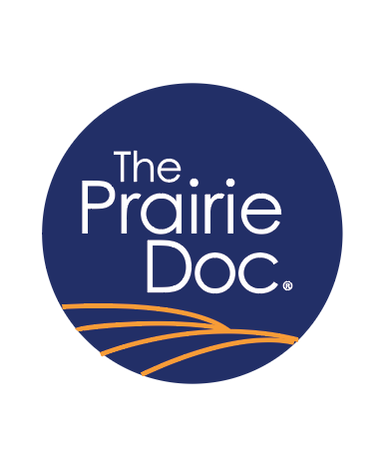|
Prairie Doc Perspective Week of September 24th, 2023
“Exercise for healthier aging” Kelly Evans-Hullinger, MD We all know that exercise is great for our overall health. Exercise is important for our cardiovascular health of course, which is why the American Heart Association recommends 150 minutes of moderate intensity exercise every week. No less importantly, and especially as we get older, another huge benefit of exercise is in fall and injury prevention. Starting an exercise routine, especially when starting from scratch, can be daunting. The simplest way to get started is to start a timed walking routine. Start with 15 minutes per day. If you can’t walk outdoors or on a treadmill, find a long hallway or a large indoor space like a store or mall and just walk. If you are consistent, you will find that week by week you will be able to increase your time ideally up to 30 minutes a day or more. If you have a friend or family member who shares the same goal, a walking partner will increase your odds of success. If you have a condition or disability that keeps you from walking, alternatives abound. Some people are much more able to use a stationary bike, or exercise in a pool. Chair exercise or upper body only routines can be found online; use the same principles, starting at 15 minutes and increasing the time gradually. Already got walking or your alternative down? You can increase the intensity by exercising more briskly or adding some hills or resistance to your routine. And better yet, you can add some strength training to maintain and build muscle. No fancy equipment needed – start with some squats from a sturdy chair; try a 30 second plank. Adding some variety to your routine is great to keep things interesting and reduce any risk of overuse injury. There are some great ways to work on exercise in a group if your community has access. Many communities have free group chair exercise or walking groups that you can try out. If able, try a yoga, pilates, or tai chi class. That pesky friend who keeps inviting you to play pickle ball – say “why not” and give it a go! Probably the most important thing to help you be consistent with exercise is to find activities that you actually enjoy doing, so don’t be afraid to try something new! Our exercise abilities and goals might change as we get older, but the benefits of moving our bodies are present at all ages. So get out there and move! You’ll be glad you did. My mother had 6 siblings, 16 aunts and uncles, and innumerable cousins. She was the first of them all to be diagnosed with breast cancer.
I think of my mom every time one of my patients tells me they aren’t concerned about breast cancer because it doesn’t run in their family. Unfortunately, that is true of most people who are diagnosed with the disease. I also think of my mother every time I do a breast exam, or teach someone else how to do a self exam. Her breast cancer was one not detectable by the mammogram technology available in the early 2000s. Even today, with 3D mammograms, not all breast cancer can be seen on routine screenings. She found her cancer herself, by noticing a change in her breast. Her diagnosis was delayed, however, because, having had multiple previous biopsies that turned out to be “nothing,” she prioritized all the other things she had to do that spring over going to her doctor. The importance of being vigilant for these changes is not limited to one gender. Although most breast cancer patients are female, approximately 1% are male. Anyone who notices a change in their breast should be seen by a clinician. Breast cancer detection has changed dramatically since my mother was diagnosed. 3D mammograms, which present clearer images to the radiologist, are routine. Contrast Enhanced Spectral mammography and breast MRI offer new tools to high risk individuals, women with abnormal screening mammograms, and their health care teams. People known to be at high risk might take medication to reduce that risk, and might undergo more frequent imaging and exams. Genetic counseling and genetic testing help us identify those who could benefit from this close follow up. Breast cancer treatment has also changed dramatically. Advances in surgical treatment have reduced the risk of post operative complications, such lymphedema: chronic swelling caused by the disruption in the flow of fluid through the lymph nodes. Specialized testing of a person’s cancer lets oncologists identify those patients most likely to benefit from chemotherapy. Conversely, it also lets them identify those who might skip it. New classes of medications offer hope even to people whose cancer has spread, and improve the tolerability and effectiveness of old medications. We’ve gotten better at helping patients, and their families, navigate the challenges that come with the disease and its treatments. Many things in medicine have changed over the 25 years I’ve been practicing. The advances in cancer treatment may well be some of the most exciting. But some old wisdom still holds true: If you notice a change in your breast, please get it checked out. Even if you had a normal mammogram a few months ago. Prairie Doc Perspective Week of September 10th, 2023
“ALS - Not Just Lou Gehrig’s Disease” By Jill Kruse, DO On July 4, 1939 Lou Gehrig said these famous words at Yankee Stadium, “For the past two weeks you have been reading about the bad break that I got. Yet today I consider myself the luckiest man on the face of the earth.” The bad break he was referring to was the diagnosis of a condition that would become synonymous with him - a neuromuscular condition called Amyotrophic Lateral Sclerosis (ALS). ALS is a disease which causes motor nerves in the brain and spinal cord to break down. This reduces the nerves ability to control muscle function leading the muscle to weaken, twitch, and waste away. As the disease progresses it slowly impairs the person’s ability to walk, talk, swallow, and breathe. Lou Gehrig was only 36 years old when he was diagnosed at Mayo Clinic in Rochester, MN. However, it is more commonly diagnosed between the ages of 55 and 75. He lived less than two years after his diagnosis with ALS. Today the average life expectancy after diagnosis is two to five years, but some people with this disease can live much longer. The famous physicist, Steven Hawking, lived for more than 50 years after he was diagnosed with ALS. The cause of ALS is still unknown. Almost all cases are considered sporadic, while only five to ten percent are thought to be inherited. One study suggested smoking may increase a person’s risk for developing ALS. Military veterans also have an increased risk of developing ALS compared to civilians. Currently there is no single test that can predict or diagnose ALS, it is based on symptoms and a multitude of tests. While there are treatments and medications that can slow the progression of the disease. There is no cure, but research is still ongoing. Over eighty years later, the final words of Lou Gehrig’s speech still serve as inspiration. “So I close in saying that I may have had a tough break, but I have an awful lot to live for.” Major League Baseball holds “Lou Gehrig Day” every year on June 2nd. That day marks the anniversary of both when he became the starting first baseman for the New York Yankees and the day he passed away in 1941. On this day, Major League Baseball raises funds to help research ALS, to find better treatments and hopefully find a cure. Lou Gehrig’s optimism and tenacity in face of such a life changing diagnosis makes it no wonder most people know ALS as “Lou Gehrig’s Disease”. Prairie Doc Perspective Week of September 3rd, 2023
“With New Knowledge comes New Discoveries” By Andrew Ellsworth, MD My son is a Boy Scout. Hopefully, he will become an Eagle Scout like his dad, his grandpa, his uncle, and not to mention eleven of the twelve men that walked on the moon. Whether he does or not, it has been an honor seeing the program help him and other boys mature into responsible young men. This summer, our troop took our canoes along the 108 miles on the Missouri River in Montana, in the Upper Missouri River Breaks National Monument. That stretch of the Missouri, where the river has carved impressive rock formations that create “breaks” in the land, is largely untouched and flows as it did for Lewis and Clark’s expedition in 1804 to 1806. Canoeing and camping along the same places as the Corps of Discovery was an amazing experience, and provided ample time to ponder the immense changes our nation has made in 200 years. Medicine has also made immense changes and progress in the last two centuries. For instance, bloodletting, which had been used for thousands of years, was still in practice at the time of Lewis and Clark, although some physicians were doing studies that showed its harms and limited benefit. Contrast that to advances today in germ theory, insulin for diabetes, surgical advances, tiny stents that can open up blood vessels in the heart and brain, x-rays, CTs and MRIs, amazing new drugs, the list is exponential. Dr. Benjamin Rush was a leading American physician at the time of the Lewis and Clark Expedition. A big proponent of bloodletting and purging, he convinced Meriweather Lewis to bring 600 of his “Rush’s Thunderbolts” pills along the journey. Containing mercury and other strong purgatives, they were used for about anything. They cleared your bowels if nothing else. Higher levels of mercury in the soil have helped identify where Lewis and Clark camped. As “Prairie Docs” we know we do not have all the answers, and some of our answers, because of science and research, can and do change with time. That is one reason we invite other medical experts to write articles and be on the “On Call with the Prairie Doc” shows. We are dedicated to enhancing health and diminishing suffering by communicating useful information, based on honest science, provided in a respectful and compassionate manner. We want to highlight the changes and progress in medicine, while also stressing the importance of good old preventative care, a healthy diet, and exercise. We do this as volunteers, because we all know the importance of providing trusted health information free to our audience. We are funded by you, our readers and viewers. Thank you for your support and trust as we begin our 22nd season. Andrew Ellsworth, M.D. is part of The Prairie Doc® team of physicians and currently practices family medicine in Brookings, South Dakota. |
Archives
July 2024
Categories |
 RSS Feed
RSS Feed


